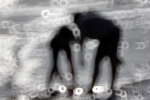« Au-delà de l'effondrement, 47 : Guerre et Guerre de László Krasznahorkai | Page d'accueil | Autour de Carlo Michelstaedter »
23/05/2015
W. G. Sebald's The Emigrants

Photography (detail) by Juan Asensio.
 Texts (in French) about W. G. Sebald's books.
Texts (in French) about W. G. Sebald's books. Les Émigrants.
Les Émigrants.Mes remerciements les plus chaleureux à Douglas Robertson, traducteur de ma note sur Les Émigrants.
 As we read the four tales that make up The Emigrants, first published in 1992 in Germany and translated into French in 1999 (1), we sink ever deeper into a strange material that is not solely made up of memories, and that therefore procures us that both delicious and troubling sensation of vertigo each time the past seems to come back to life, gleaming with strange precious stones made out of a different material, a material that is certainly not the fragile and tender one called nostalgia, let alone banal melancholy, but rather the material that one surmises is as hard and as sharp-edged as a stubborn piece of rock breaking through the loose topsoil, a material which allows us to surmise, under the placid surface appearance of things and the smooth organization adopted by the beings that are conjoined to them, a dangerous reality, a reality appearing thanks to the intervention of the dream, of a bizarre sensation, of the both physical and moral decrepitude of the characters whom Sebald evokes, when it is not a question of the slow deterioration of places, places that after all are also mysteriously contaminated by the thoughts of the men and women who have traversed them in the space of a few hours or of an entire life.
As we read the four tales that make up The Emigrants, first published in 1992 in Germany and translated into French in 1999 (1), we sink ever deeper into a strange material that is not solely made up of memories, and that therefore procures us that both delicious and troubling sensation of vertigo each time the past seems to come back to life, gleaming with strange precious stones made out of a different material, a material that is certainly not the fragile and tender one called nostalgia, let alone banal melancholy, but rather the material that one surmises is as hard and as sharp-edged as a stubborn piece of rock breaking through the loose topsoil, a material which allows us to surmise, under the placid surface appearance of things and the smooth organization adopted by the beings that are conjoined to them, a dangerous reality, a reality appearing thanks to the intervention of the dream, of a bizarre sensation, of the both physical and moral decrepitude of the characters whom Sebald evokes, when it is not a question of the slow deterioration of places, places that after all are also mysteriously contaminated by the thoughts of the men and women who have traversed them in the space of a few hours or of an entire life. In the first of the work’s tales, Dr. Henry Selwyn shows the author not only a kitchen garden fallen into ruin, but also some “Victorian greenhouses” and some “overgrown espaliers,” for it is not only “the kitchen garden…that’s on its last legs after years of neglect,” but also nature itself which is “groaning and collapsing beneath the burden we placed on it” (p. 7), and is threatened by “the progressive destruction of natural life” (p. 45). It is also under the burden of that which we seem to place on it that our spirit withdraws and sometimes suffers one of those crises so common in the texts of Sebald during which, sometimes for entire decades, the images of this or that episode from the past are effaced from the memory, only to return to it dolorously, provoking anew a crisis that one will have to try to cure while setting off in search of the lost memory, or, rather, the memory that is almost lost and yet is capable, like a long-forgotten cadaver, of returning to the surface of the earth once the glaciers have freed it from their grip, emerging from its prison and “at the edge of the moraine,” (p. 23) or like the reminiscence of Paul Bereyter, the excellent teacher from Sebald’s earliest schooldays, who more and more frequently becomes the object of the author’s preoccupations, without our really knowing why.
He must then attempt, “[quite belatedly],” Sebald specifies, at the risk of interrupting his research on “the history of Bering’s Alaska expedition,” (p. 32) of which we know nothing, to approach the person who has mysteriously appeared in his mind, at the risk of subjecting him to a veritable investigation, which alone will be capable of fortifying the author against the “emotional moments” which he finds “wrongful” and “in order to avoid” which he tries to “write down what [he] know[s] of” him (p. 29), even if, of course, the boundaries between objectivity and subjectivity thrown into relief here are very quickly denied by the author himself, to whom it seems “as if the dead were coming back, or as if we were on the point of joining them,” (p. 46) the dead , especially those of them who, like Paul Bereyter, commit suicide by laying themselves down across a railway track, never ceasing to pester and interrogate us, the man confusedly foreseeing that these railway tracks “lead to death,” (p. 61) as they had led to death hundreds of thousands of certain Jews whom we meet again in the following tale, the very beautiful “Ambros Adelwarth”; at any rate, we meet their ancestors who naturally have never experienced the Holocaust, piled up in the thousands in the Bowery and “the whole of the Lower East Side,” which until the First World War constituted “the districts where the immigrants chiefly came to live,” (p. 83) a prefiguration, in short, of that “edge of darkness” that uncle Kasimir speaks of and in fact, Sebald remarks, “it seemed as if the mainland were submerged behind us and as if there were nothing above the watery waste but this narrow strip of sand running up to the north and down towards the south,” (p. 88) on which the author’s relative has photographed himself. In Sebald, everything lingers—the living and the dead, memories and their occultation, places and those who have lived in them, the apparent tranquility of life and the gulfs of horror that it contains.
But the past—although diabolically tenacious, since it fairly oozes from every line of Sebald’s texts and seems to impregnate them with a murky phosphorescence—constitutes the very fabric against which the slightest words and gestures of his characters stand out in order to acquire an aura of the fantastic, but the past is something that one must distance oneself from even while summoning it up, perhaps by means of the curious ruse by which Great-Uncle Adelwarth extirpates the accursed seed from his own flesh: “Even the least of his reminiscences, which he fetched up very slowly from depths that were evidently unfathomable, was of astounding precision, so that, listening to him, I [i.e., Aunt Fini] gradually became convinced that Uncle Adelwarth had an infallible memory, but that, at the same time, he scarcely allowed himself access to it” (p. 100). And so, the more “Uncle Adelwarth told his stories, the more desolate he became”; it is therefore hardly surprising when he sinks “into such a deep depression that, although he plainly felt a great need to talk about his life, he could no longer shape a single sentence, nor utter a single word, or any sound at all,” (p. 103), something that will not make him scruple to take his next step, that of voluntarily checking in to a sanatorium in Ithaca; a member of the faculty of that sanatorium, Dr. Abramsky, alludes in Sebald’s presence to the inhumane treatment vouchsafed to the residents of this now abandoned, mouse-infested place; most likely no-one, he says, can imagine “the pain and wretchedness once stored up in this extravagant timber palace,” and Dr. Abramsky hopes that it “will gradually melt away now as it falls apart,” (p. 110) and incessantly dreams of the outright “collapse” (p. 112) of this House of Usher-esque structure in which Sebald’s great-uncle has voluntarily immured himself with the aim of attaining “an extinction as total and irreversible as possible of his capacity to think and remember” (p. 114). Sebald’s texts invariably--in their own enigmatic, subtle, undoubtedly fragile, and maliciously modest fashion—rebel against collapse, against silence become muteness, against a language that is at a loss for resources in the face an excess of suffering or else of a cataclysmic experience that leaves its survivors distraught in the midst of the ruins.
Destruction is an actuality; moreover, it has never left us, and it is this destruction that Sebald sees at work when he travels to Deauville in 1991, because he immediately realizes that “the once legendary resort, like everywhere else that one visits now, regardless of the country or continent, was hopelessly run down and ruined by traffic, shops and boutiques, and the insatiable urge for destruction,” (p. 116) and yet it is at Deauville that Sebald is visited by a long dream in which he rediscovers the enigmatic figure of his great-uncle, never separated for long from his friend Cosmo, both of them evoked in the context of a journey to the Holy Land recounted in a 1913 pocket diary; the two men coming to life before our eyes via the brief entries in Adelwarth’s notebook as they travel in a landscape that, although bathed in a unique and perhaps miraculous light, seems stricken by an ancient curse, as we observe at Jerusalem, which makes a highly unfavorable impression on the two travelers and even triggers a disagreeable memory, a memory that seems like “a kind of dumbness” to the man who is doing everything he can to expel them: “It makes one’s head heavy and giddy, as if one were not looking back down the receding perspectives of time but rather down on the earth from a great height, from one of those towers whose tops are lost to view in the clouds” (p. 145) and on one of which another of Sebald’s relatives, Uncle Kasimir, may have worked (p. 85), a circumstance that affords him a view of Ambros’s curious life.
It is the last tale, entitled Max Ferber, which affords us the greatest number of signposts on Sebald’s art of writing, which seems to be intimately bound up with suffering, whether in connection with the moment of writing itself or with the events recounted by it. And so, recalling his arrival in the city of Manchester which seems no longer to be anything but “a necropolis or mausoleum,” (p. 151), a victim of “some massive shipping disaster,” (p. 160) Sebald observes that it is the contemplation of a strange apparatus, christened a teas-maid, that “kept [him] holding on to life at a time when I felt a deep sense of isolation,” (p. 154) a time when he could have become estranged from life definitively.
Be that as it may, Sebald’s writing is as very much as lengthy as it is dolorous2 in its gestation, and its slow process of crystallization around a forgotten figure or gesture bears comparison with the spectacle that he contemplates in a saline solution, when the author, gazing at the “ceaseless flow of the water,” is unable moreover to separate the spectacle of the “ruminations about the long term and ([he] believe[s]) impenetrable process which, as the concentration of the salts increases in the water, produces the very strangest of petrified or crystallized forms, imitating the growth patterns of Nature even as it is being dissolved” (p. 230).
Sebald’s writing also resembles Max Feber’s method of drawing: “He might reject as many as forty variants, or smudge them back into the paper and overdraw new attempts upon them, and if he then decided that the portrait was done, not so much because he was convinced that it was finished as through sheer exhaustion, an onlooker might well feel that it had evolved from a long lineage of grey, ancestral faces, rendered unto ash but still there, as ghastly presences on the harried paper.” (p. 162). This lengthy sedimentary process by which a face emerges while revealing the ancestral features of which it is composed seems itself to be nothing other than one of the variants of the prodigiously subtle and tortuous chain that unites the characters Sebald evokes, and we are accordingly unsurprised to learn that Max Ferber has lived “at 104, Palatine Road—the selfsame house where Ludwig Wittgenstein, then a twenty-year-old engineering student, had lived in 1908,” (p. 166) as if a “sense of brotherhood that reached far back beyond his own lifetime or even the years immediately before it” (p. 167) constituted the actual web against which the totality of facts and gestures, pasts, presents, futures, and of the people to whose fates Sebald becomes attached, stands out; moral suffering being thus “effectively without end,” (p. 170) in contrast to physical suffering, which forms the invisible milieu which is adhered to by all acts, all thoughts, and also all memories, whose secret peregrinations nonetheless keep them at a distance, and by spirits, before the latter pounce on their prey, having seemingly reconstituted themselves after being worn away.
Thus, it is clear that time is nothing more than an illusion or rather, in the terms of a quite beautiful definition, that it “is nothing but a disquiet of the soul,” (p. 181) and that one must therefore pursue the work one has embarked on “to the finish, till your heart breaks,” (p. 193) from tale to tale, at first that of Max Ferber, then that of Luisa Lanzberg, Ferber’s mother, while rediscovering those beautiful Jewish names, “so intimately bound up with the country they lived in and with its language,” (p. 224) and of which the Germans were, according to Sebald, jealous, since it is always a question, in short, of evoking the patient, methodical, and infernal work of destruction: “Naturally,” Max Ferber confides to us, “I took steps, consciously or unconsciously, to keep at bay thoughts of my parents’ sufferings and of my own misfortune and no doubt I succeeded sometimes in maintaining a certain equability by my self-imposed seclusion; but the fact is that that tragedy in my youth struck such deep roots within me that it later shot up again, put forth evil flowers, and spread the poisonous canopy over me which has kept me so much in the shade and dark in recent years” (p. 191) and, struggling against them, to recall to life that which “the mental impoverishment and lack of memory that marked the Germans, and the efficiency with which they had cleaned everything up” have attempted to efface: the appalling and sometimes, rarely, luminous suffering of human beings.
Notes
(1) Translator’s Note: The Emigrants (Die Ausgewanderten, 1992; translated from the German by Michael Hulse; New York: New Directions, 1996.) All page numbers in parentheses refer to this edition. In the original version of this essay, Mr. Asensio quotes from Patrick Charbonneau’s 1999 French translation.
(2) “During the winter of 1990/91, in the little free time I had (in other words, mostly at the so-called weekend and at night), I was working on the account of Max Ferber given above. It was an arduous task. Often I could not get on for hours or days at a time, and not infrequently I unraveled what I had done, continuously tormented by scruples that were taking tighter hold and steadily paralyzing me. These scruples concerned not only the subject of my narrative, which I felt I could not do justice to, no matter what approach I tried, but also the entire questionable business of writing” (p. 230).




























































 Imprimer
Imprimer